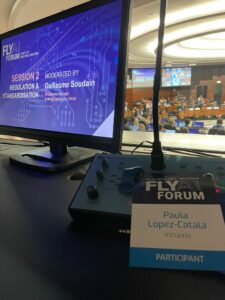
The evolution of AI in Aviation: from AI-infrastructure to LMM
Paula Lopez
In 2020, Eurocontrol and other industry representatives delivered the FlyAI Report. This report aimed to consolidate the sector’s initiatives and progress in adopting AI techniques and technologies, ranging from exploration (primarily SESAR exploratory research projects) to deployment (involving entities like Eurocontrol, Honeywell, and Heathrow).

A key focus of the report was on data availability as a critical enabler for AI adoption in aviation. Data sharing, governance, quality standards, data collection and preparation remain hot topics in our sector. To address these challenges, the 2020 FlyAI Report advocated for a federated AI infrastructure—a “unique European AI infrastructure for the aviation/ATM community”—that could host and provide access to data and a data preparation environment for all European aviation/ATM AI actors. However, despite numerous strong initiatives at the time (e.g., AirSense, DataBeacon, OpenPrisme, Skywise, Topsky, Data4Safety, GAIA-X), this ideal of a single federated AI infrastructure did not materialize. Instead, these platforms have evolved into specialized data and AI infrastructures focusing on specific applications and developments. For instance, the DataBeacon platform led to the creation of Victor5, which offers ATC and airport products.
While no new editions of the FlyAI Report have been published, the initiative has transformed into a series of webinars and conferences. These events, though not exhaustive, provide valuable insights into the industry’s AI adoption. They cover transversal topics such as standardization, regulation, cybersecurity, and human-AI teaming, alongside applications that highlight sector trends. The 2023 edition showcased a wide array of applications and technologies, while the 2024 FlyAI forum emphasized potential applications of generative AI and large language models (LLM) in aviation. Discussions ranged from high-level strategies to specific applications like airline operations assistance, NOTAM interpretation, drone flight planning, and customer service chatbots. Last year, we also published a post on this blog about the potential application of ChatGPT for coding.

Looking ahead, the focus on emerging technologies like generative AI and large language models presents new opportunities and challenges. By staying at the forefront of these developments, the industry can enhance operational efficiency, safety, and customer experience. Of course, it is important to maintain a clear strategy to efficiently address these challenges, focusing on leveraging the most useful technologies rather than adopting trendy solutions for their own sake. As we continue to track these trends, our blog will provide insights and updates on the latest advancements and their implications for the aviation sector.
Stay tuned for more on how AI is transforming the skies!
1 FlyAI Report by ACI, Airbus, ASD, CANSO, Eurocontrol, Heathrow, Honeywell, IATA, IFATCA, IFATSEA, SESAR, Thales, EDA and NATO


